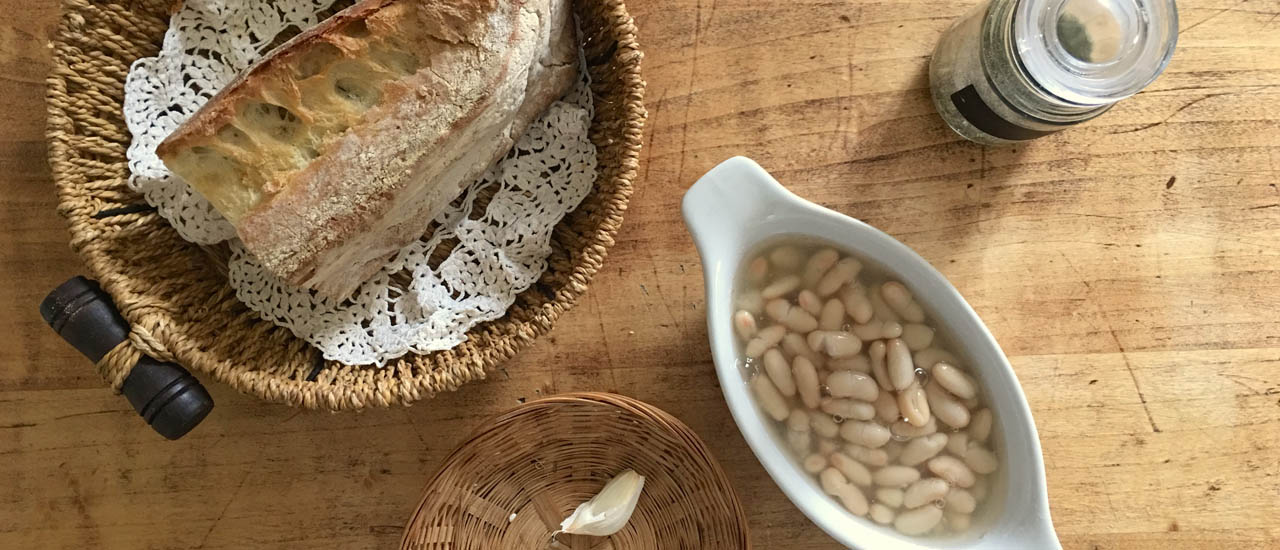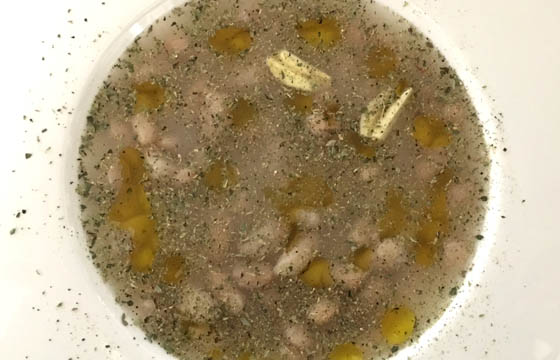Ingredients
 800 g of Spollichini (fresh Cannellini beans)
800 g of Spollichini (fresh Cannellini beans) 2 cloves of garlic
2 cloves of garlic Oregano to taste
Oregano to taste Extra virgin olive oil to taste
Extra virgin olive oil to taste Salt to taste
Salt to taste White pepper to taste
White pepper to taste 8 slices of stale bread
8 slices of stale bread

In Campania, especially in Naples, beans occupy a prominent place in the local cuisine. They are the protagonists, in their many varieties, of many recipes. Pasta and beans, the one that is so creamy and dense, that if you overturn the dish, it does not fall down, is one of the major attractions in the taverns of Naples and the surrounding area. In “Maruzzara” style, with mussels or pork rind, beans lend themselves to various traditional interpretations. Unlike other legumes - chickpeas, lentils, fava beans and grass peas - used already in ancient times in Mediterranean regions, beans are relatively recent, coming from the Americas, along with many other vegetables, in their many varieties. Over time, many species of beans have been adopted in Campania, for instance, the Tondino, the Controne and the Formella. However, the protagonist of this recipe is the summer bean, the Spollichino, which in other parts of Italy is called the Cannellino. The peculiarity of this product is that it is eaten fresh and not dried after cultivation, as in most cases. When, in late spring, the Spollichini time comes around, it is possible to see the elderly parents of fruit-sellers materialize everywhere in the streets of Naples. They sit in the shade, in front of the boxes outside the shops, and with great patience shell beans all day long, storing them in small bags ready for sale. Everything is poetry in our small alleys. This is the summer recipe for the tender Spollichini cooked without tomato and then seasoned with some oil and a lot of fresh oregano. Here in Naples, even oregano has its own story. Simplicity and patience, that’s the recipe. The beans must simmer for at least an hour and a half, under watchful eyes to check that the temperature is constant and that they turn out soft and compact. Recipe after recipe, ingredient after ingredient, Neapolitan culture takes on its own character: the cult of small things, the patience of preparing dishes with care and tradition, the small and immense pleasure of enjoying them in good company, the smell of oregano and the thin column of vapour rising from a simmering pot, the summer that is about to come.
 800 g of Spollichini (fresh Cannellini beans)
800 g of Spollichini (fresh Cannellini beans) 2 cloves of garlic
2 cloves of garlic Oregano to taste
Oregano to taste Extra virgin olive oil to taste
Extra virgin olive oil to taste Salt to taste
Salt to taste White pepper to taste
White pepper to taste 8 slices of stale bread
8 slices of stale bread

Since these are fresh beans, they do not need to be softened in water like the dry ones. After shelling them, put the beans in a pot full of cold water with a bit of sodium bicarbonate, and start the cooking process. When the pot reaches the boil, lower the flame to the minimum, cover the pot with a lid, leaving it slightly raised with a ladle. Let them cook for at least one hour or until the beans are soft.

Turn off the flame and allow the beans to cool in their water. To prepare the soup, turn on the stove again and warm the beans up. Take out a portion of beans mixed with cooking water and put it in the serving bowl. Meanwhile, cut the stale bread into cubes.

Remove the core from the clove of garlic and add it to the beans. Add salt, pepper and oregano to taste, sprinkle with oil and serve with the bread cubes.